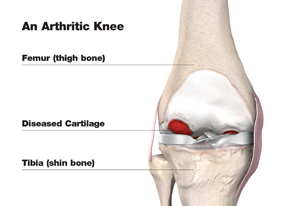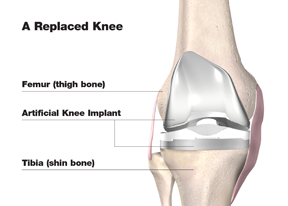Knee Anatomy and Function
The knee is the largest joint in the human body
A joint is formed by two or more bones that are connected by thick bands of tissue called ligaments. The knee is the largest joint in the body and is made up of three main parts:
- The lower end of the thigh bone, or femur
- The upper end of the shin bone, or tibia
- The kneecap, or patella
The thigh bone (femur) turns on the upper end of the shin bone (tibia), and the kneecap (patella) slides in a groove on the end of the thigh bone. Ligaments, which are bands of tissue, connect the thigh bone and the shin bone to help keep the knee joint steady. The quadriceps, the long muscles on the front of the thigh, help strengthen the knee.
A smooth substance called articular cartilage covers the surface of the bones where they touch each other within the joint. This articular cartilage acts as a cushion between the bones. The rest of the surfaces of the knee joint are covered by a thin, smooth tissue liner called synovial membrane, which makes a small amount of fluid that acts as a lubricant so that the joint bones will not rub against each other.



What Causes Knee Pain?
One of the most common causes of knee pain and loss of mobility is the wearing away of the joint’s cartilage lining. When this happens, the bones rub against each other, causing significant pain and swelling. The most common cause is a condition known as osteoarthritis. Trauma or direct injury to the knee can also cause osteoarthritis. Without cartilage there is no shock absorption between the bones in the joint, which allows stress to build up in the bones and contributes to pain.
Your Treatment Options for Knee Pain
You may be able to get pain relief from treatments like steroidal and nonsteroidal anti-inflammatory drugs, physical therapy, bracing, and cortisone injections. But if you’ve tried these methods and haven’t experienced adequate relief, you don’t have to live with severe knee pain and the limitations it puts on your activities.
Knee replacement surgery may provide the pain relief you long for and enable you to return to the things you enjoy doing. Remember, even if your doctor recommends knee replacement for you, it is still up to you to make the final decision. The ultimate goal is for you to be as comfortable as possible with your choice — and that always means making the best decision based on your own individual needs.
If you do choose surgery, you’ll be in good company: More than a quarter-million Americans have knee replacement surgery every year.1 First performed in 1968, the procedure typically relieves pain and restores joint function.
References:
1. Arthritis Foundation – February 2006

